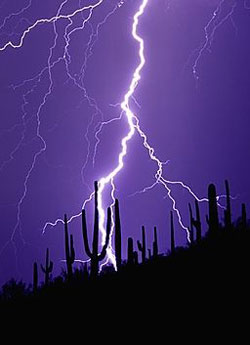|  Lightning is a high energy stepped waveform pulse. Rapidly changing steps in voltage contain high frequency energy. This energy has a peak in the dozens or hundreds of kilohertz, with the bulk of energy ranging from low AC frequencies to perhaps 1MHz. Damaging energy extends to hundreds of megahertz. Lightning should be considered a dc to VHF energy source with the bulk of energy at lower frequencies. Current is massive, thousands of amperes can flow in a lightning strike. A good ground must have a very low impedance over a very wide frequency range. This rules out thin wires, and loosely woven braided conductors should be avoided. The very best ground leads are solid wide smooth surfaces, although braiding sometimes must be used in areas that demand conductor flexibility. Lightning is a high energy stepped waveform pulse. Rapidly changing steps in voltage contain high frequency energy. This energy has a peak in the dozens or hundreds of kilohertz, with the bulk of energy ranging from low AC frequencies to perhaps 1MHz. Damaging energy extends to hundreds of megahertz. Lightning should be considered a dc to VHF energy source with the bulk of energy at lower frequencies. Current is massive, thousands of amperes can flow in a lightning strike. A good ground must have a very low impedance over a very wide frequency range. This rules out thin wires, and loosely woven braided conductors should be avoided. The very best ground leads are solid wide smooth surfaces, although braiding sometimes must be used in areas that demand conductor flexibility.
Most of the time damage comes from lightning strikes on power lines. Lightning most often follows the utility lines to the house, through house wiring to equipment, and to ground in antenna systems. The real danger is lightning flowing through the equipment and house wiring to seek a ground. Read this page link station ground. With taller towers, lightning can be a frequent unwelcome visitor. Tall structures often require a large-area ground with low impedance, wide, smooth copper flashing or heavy gauge solid wire surrounding critical areas, such as a work area or equipment area near the tower base. Tall towers need a ground that rapidly and evenly spreads charges out over a wide area. The goal is to prevent objects near the structure from rising significantly faster in voltage than other objects located near the tower. Very high currents can flow between things near the tower, it is important to provide a low-impedance path for these currents. Lightning grounds should always provide a common low impedance path between everything conductive entering a building. This means power lines, telephone lines, TV antennas, and metallic conduits or pipes should all share a common ground connection buss that has very low impedance. Normally the lowest impedance connection is provided by a wide smooth surface copper flashing, although very heavy round copper can be used. Round copper has lower RF resistance per unit length for a given surface area, but flat wide copper has less reactance and lower overall impedance. This is because fewer magnetic flux lines encircle any given area of wide strip than enclose the surface area of a compact conductor. In effect the magnetic field is "spread out", reducing inductance. A good lightning ground is generally a good equipment fault safety ground, but it might not be a good RF ground! RF grounding sometimes requires shielding of the earth from radio frequency fields, or moving the RF energy out of the lossy soil. Lightning generally requires we connect to the earth, and freely move energy into or out of lossy soil. Certain RF ground applications require minimizing RF current flowing into lossy soil. |
| Radios that operate from power mains stand a chance of having the power line accidentally fault to the chassis. Worse yet, a linear amplifier with high voltage power transformer might develop a secondary to primary short, and that short might cause the chassis to rise to peak secondary voltage plus peak primary voltage! An amplifier with a 2400 volt RMS transformer operating on 120 or 240 volt USA power mains might have a chassis voltage as high as 3600 volts from a secondary to primary failure inside the transformer.
Any advice saying our equipment doesn't require a safety ground connection is very bad advice. All power mains operated amateur radio gear, especially devices with HV inside, requires a safety ground.
The safety ground does not really need a ground rod, it actually only requires a connection back to the power mains service entrance ground though a very heavy conductor. It may be desirable to augment this safety ground connection with a few extra earthing ground rods. As with lightning grounds, any special safety ground must bond to the utility entrance ground. A good lightning entrance ground also makes a good safety ground, provided it is brought from the entrance point panel to the operating area where equipment is bonded into the ground. Do not go outside beyond the entrance panel barrier with this ground lead.
Equipment with properly installed safety ground plugs, provided wiring and plugs are up to current codes, do not require a special safety ground connection. They are grounded through house wiring. |

